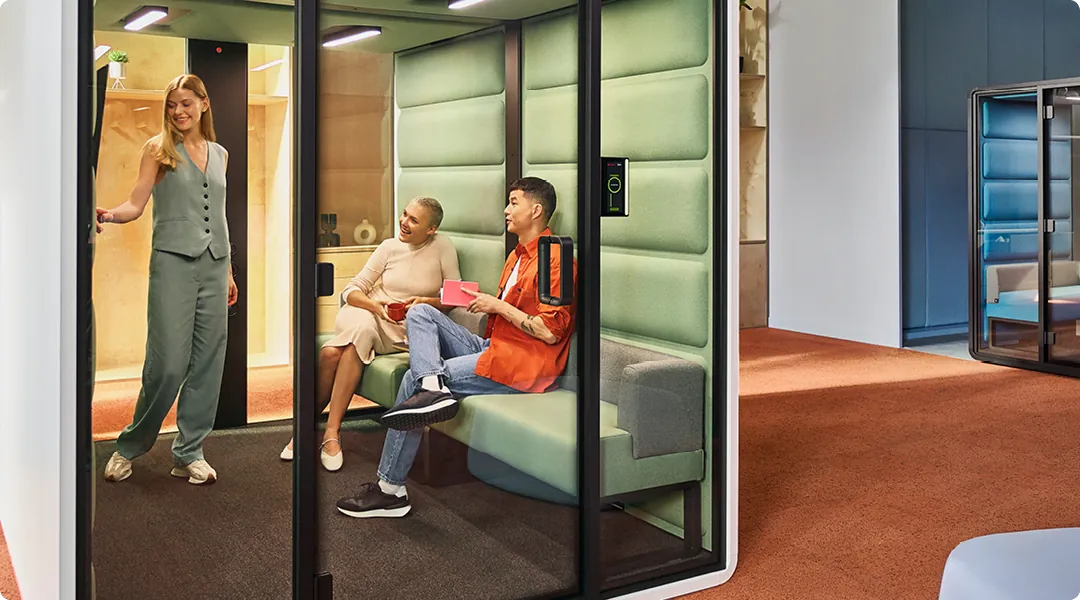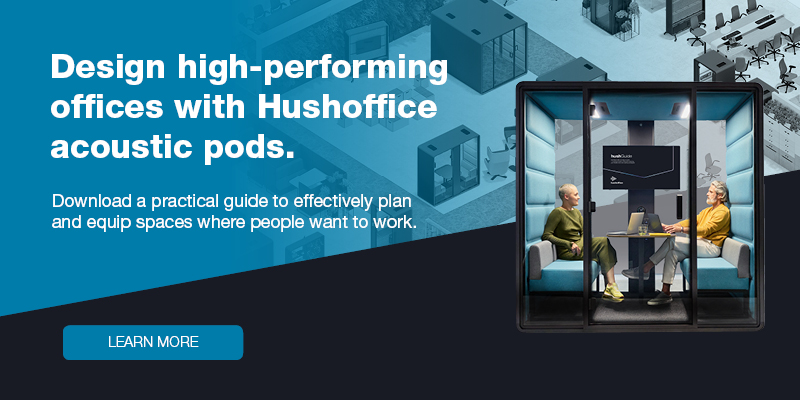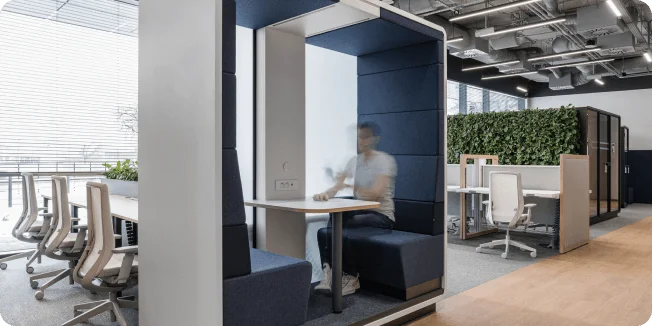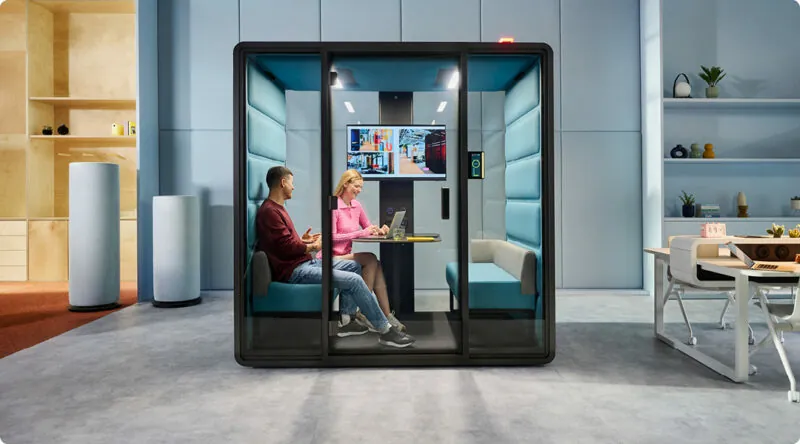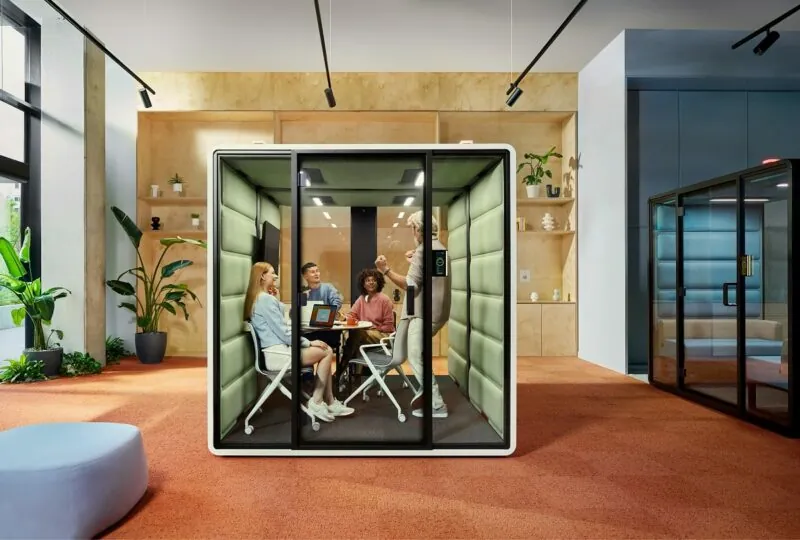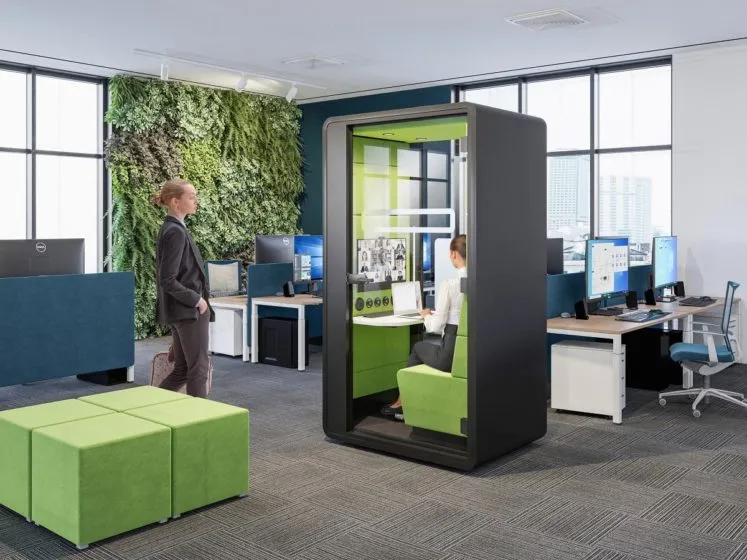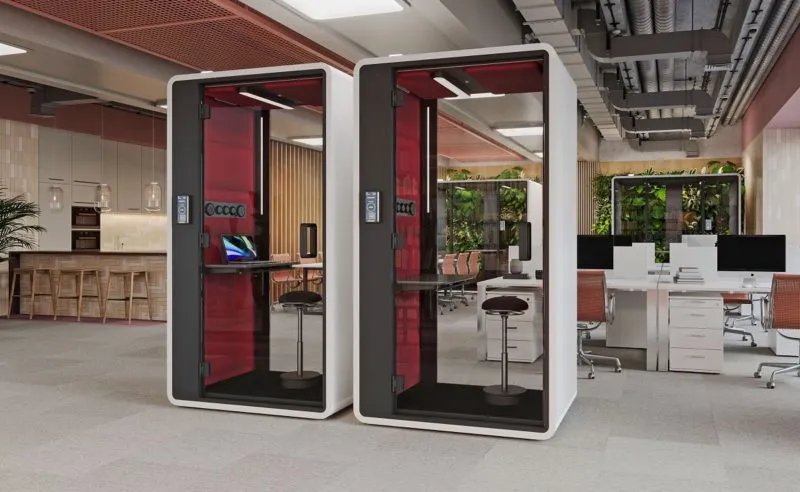Acoustic pods — the ideal space for employee feedback
- Posted on: 3 April 2024
- By: Hushoffice Team
92% of workers express a preference for more frequent feedback on their performance compared to the typical once-per-year frequency. Interestingly, 49% of respondents prefer to receive feedback at least once a week, while 72% prefer receiving it from their manager on a monthly basis. What’s the best space within the office to have such discussions? Acoustic pods and booths, we believe. Why? Let’s find out.
92% of workers express a preference for more frequent feedback on their performance compared to the typical once-per-year frequency. Interestingly, 49% of respondents prefer to receive feedback at least once a week, while 72% prefer receiving it from their manager on a monthly basis. What’s the best space within the office to have such discussions? Acoustic pods and booths, we believe. Why? Let’s find out.
Spaces for employee feedback – tl;dr
Low-stimuli environments contribute to overall well-being. When the brain becomes overwhelmed with cognitive input, it may struggle to process information or even experience partial shut down. This happens because, in response to overstimulation, our bodies absorb serotonin, the neurotransmitter associated with happiness. A decrease in serotonin levels can be an issue as an ample dose of serotonin is essential for maintaining the right mood during sensitive discussions.
Providing compact meeting areas fosters close proximity among meeting participants, which increases the mutual empathy levels. And such reciprocated empathy is essential for conducting effective check-in meetings.
Offer customisable lighting whenever possible to accommodate the changing needs of meeting participants. While brighter lighting may stimulate emotions more, the calming ambience created by dimmed lights is more effective when rational, emotion-free thinking should be prioritised. Customisable lighting grants the meeting host autonomy over the meeting space, especially when striking a balance between these contrasting needs is required.
Thoughtfully select the furniture for every meeting space. While rounded seating setups fulfil the human need to belong, rectangular seating arrangements allow a group to appoint the head, establishing a desired hierarchy of authority. Additionally, soft furnishings promote a more relaxed atmosphere for negotiations, while solid furniture tends to encourage rigidity.
Why is a peaceful environment essential in employee appraisals?
Disturbing background noise, visual clutter, harsh lighting, and peripheral activities all disrupt tranquillity, hindering individuals’ ability to fully concentrate on the meeting. This presents a major difficulty as peace and quiet are essential for performance reviews, which are challenging enough by their very nature.
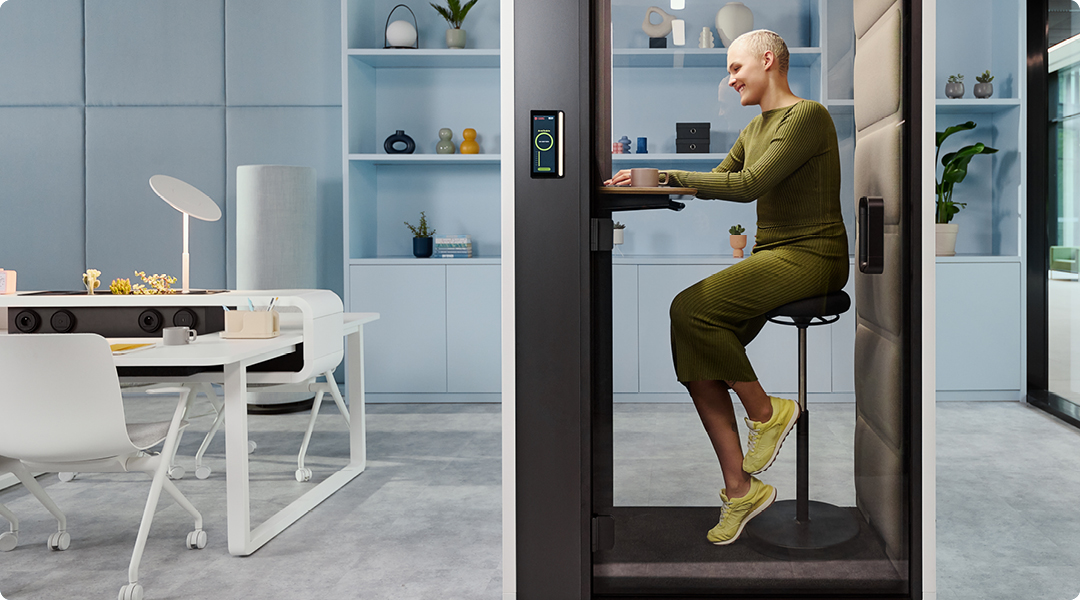
When it comes to employee performance reviews, there are a couple of golden rules to follow that will ensure successful communication. First and foremost: clarity is paramount, so be specific in your evaluations. Encourage your colleague to approach the meeting with an open mind, so that your comments aren’t considered unsolicited advice. Another crucial point is to show empathy or a sufficient degree of care to guide the communication towards mutual understanding. And the most valuable support for productive one-to-one meetings is undoubtedly a private, self-contained meeting space, such as hushFree.M. With its impeccable, acoustically-designed interior, it offers employees the ultimate security, ensuring the peace of mind indispensable for an open back and forth
– says Mateusz Barczyk, Senior Brand Manager, Hushoffice.
Our physical environment has an impact on our receptiveness and honesty.
The workspace significantly impacts workers’ attitudes, behaviours, overall satisfaction, and productivity. While acoustically-insulated spaces provide a sense of privacy and freedom from judgement, background sounds can hinder effective communication by constantly diverting focus.

It’s all about ensuring emotional security, or psychological safety.
When employees are afforded emotional security, they feel empowered to share their opinions and concerns freely, without the fear of any consequences. This delicate sense of psychological safety is central to employee appraisal meetings, supporting constructive efforts rather than destructive ones. In a nutshell, when individuals feel safe, they are simply more likely to actively engage in communication.
Architect Donald M. Rattner’s comprehensive study of the psychology of spaces offers practical advice on creating safe workspaces within the office, essential for facilitating effective feedback. Studies show that employees generally prefer soft furnishings with curved lines over hard edges as they convey a sense of safety. Similarly, research highlights the importance of skillful design in creating a homey atmosphere within the office, as such environments ensure psychological safety. When achieved, this fosters open, transparent communication in the workplace. With Rattner’s scientifically-based recommendations in mind, we believe that pods and booths are an excellent choice for providing employees with private meeting areas. Professional, comfortable, and functional, private pods, such as hushFree, feature supportive seating and upholstered interior panelling, offering a quiet retreat where employees can feel comfortably relaxed during performance reviews
– says Mateusz Barczyk, Senior Brand Manager, Hushoffice.
Physical privacy is a robust groundwork for psychological safety at work.
In the past, our ancestors sought shelter for safety, but today’s working environments should provide employees with calmness and peaceful isolation. These quiet spaces resemble caves – they are low-stimuli dens that offer workers a refuge from the workspace commotion as well as a sense of protection and seclusion.
Acoustic pods and booths foster psychological safety to guarantee successful employee appraisals.
Architecture is crucial in establishing a sense of safety within a given space. In general, areas characterised by acoustic and visual calmness, along with soft furnishings and cosy seatings tend to arouse a feeling of safety. However, to achieve the sense of true security, a space should also have some degree of physical enclosure.
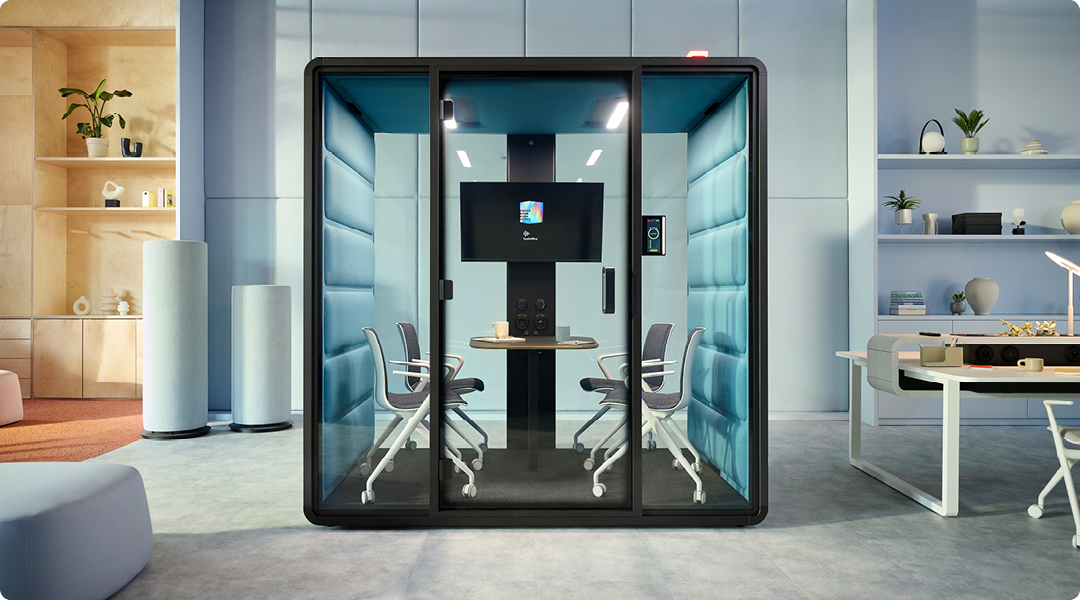
Office pods and booths offer an exceptional degree of peace and quiet.
Remarkably, within soft furnishings, people tend to negotiate more flexibly, while more rigid chair arrangements impose more stiffness. Office pods are minimalist, elegant, and cosy at the same time. Undoubtedly, their comfortable design fosters a sense of security, thereby enhancing the connection and communication among employees.
Booths cancel out background noise, improving employees’ mental state.
When overwhelmed with cognitive input, the brain may struggle to process information or even experience partial shut down. This happens because, in response to overstimulation, our bodies absorb serotonin, the neurotransmitter associated with happiness and calmness. And with less serotonin, we may experience anxiety or depression.
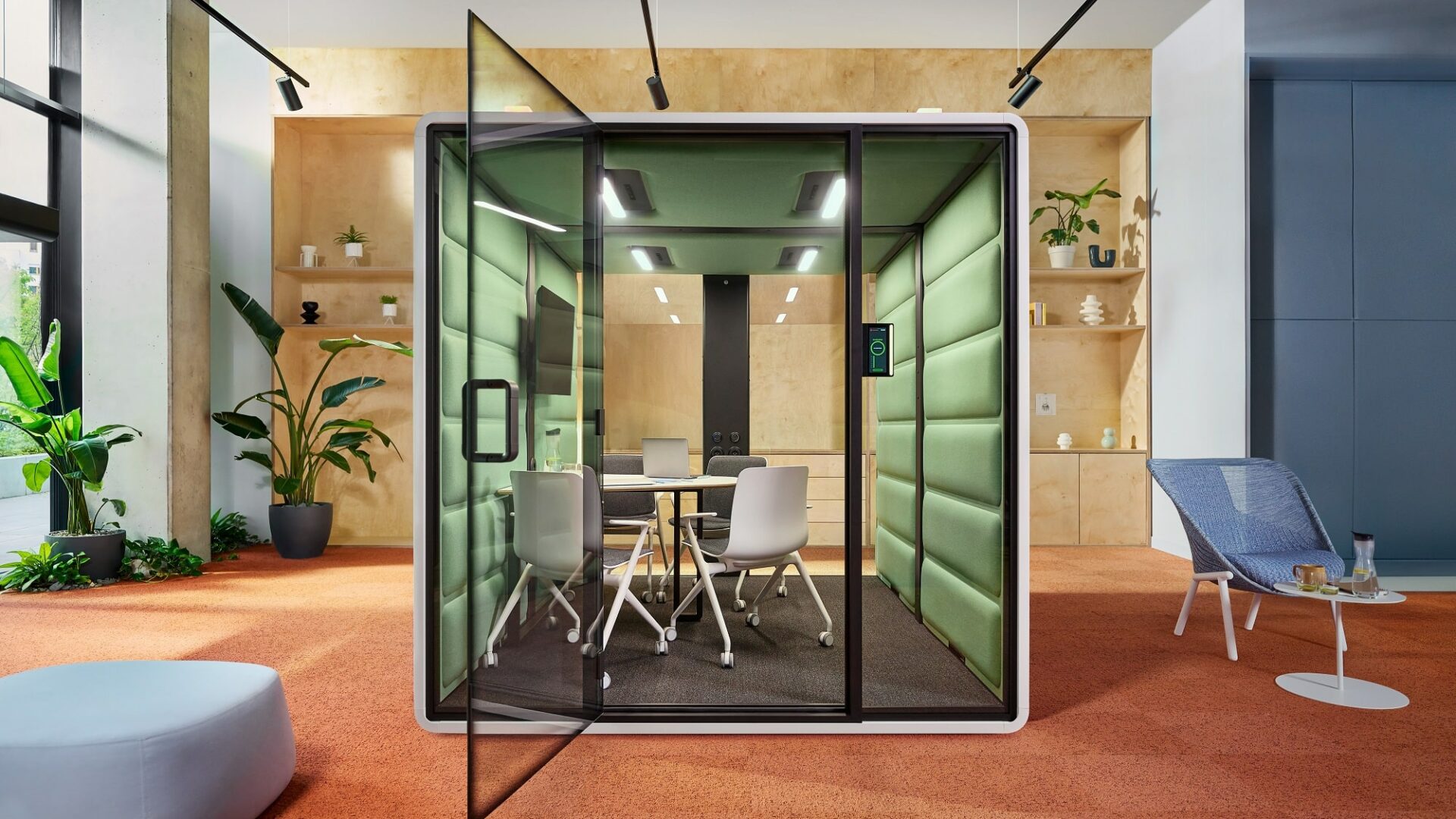
Compact and homey, office pods foster mutual understanding between individuals.
Close proximity among meeting participants increases mutual empathy, which is central to deeper understanding, allowing two individuals to navigate a challenge together. Office pods offer compact meeting spaces, facilitating private discussions and allowing everyone to be heard.
Acoustic work booths enhance concentration and foster understanding by cancelling out office noise.
Exposure to noise leads to an increase in stress hormones, such as norepinephrine, resulting in hindered concentration and reduced sensitivity to others. Moreover, noise may impede individuals’ attention span and comprehension. Work booths can help minimise distracting sounds, offering an environment for deep, focused presence.
Acoustic cabins facilitate productive discussions.
Sound insulation ensures clear, uninterrupted speech, while customisable ventilation provides lasting comfort during extended discussions. User-adjustable lighting allows for the creation of an adequate degree of intimacy. Altogether, acoustic cabins are spot-on for effective one-to-one meetings.
Systematic feedback is essential for employee engagement and performance.
80% of workers receiving relevant feedback on a weekly basis are fully engaged. Remarkably, employees are 3.6 times more likely to achieve outstanding results when provided with daily (rather than annual) feedback.
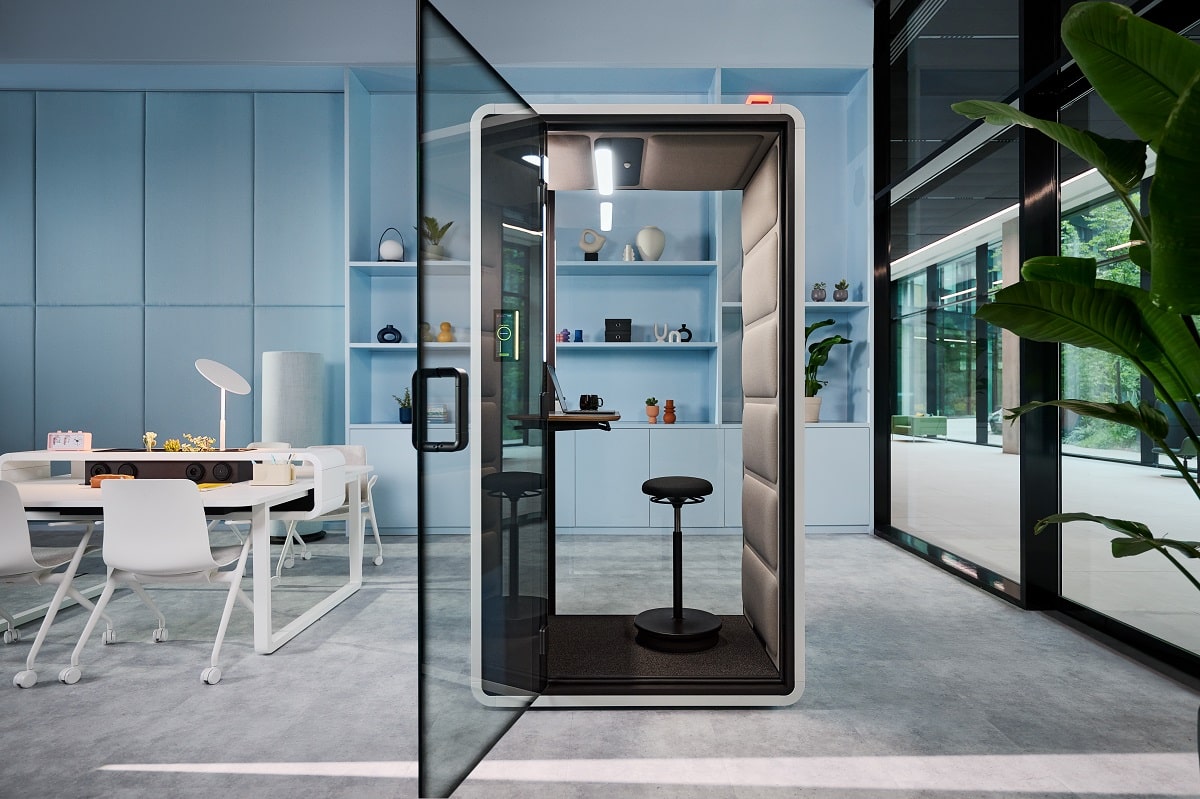
Feedback within the open space and feedback in the hushFree.L booth: chaos versus peacefulness.
While discussions on the open floor are subject to continuous distractions, meeting in pods, such as hushFree.L, allows you to concentrate on the subject at hand, maintaining undisturbed focus.
HushFree.L is an excellent meeting solution that can serve many purposes. Available furnished or unfurnished, it provides you with an opportunity to adjust the space to meet your teams’ particular needs. Furniture is the key element that has a predictive influence on the direction of the meeting. In fact, three studies have highlighted the importance of the seating arrangement configuration, specifically. For example, circular-shaped setups foster a need to belong, encouraging mutual agreement. With its premium acoustics, guaranteed privacy, and arrangement flexibility, booths such as hushFree.L can be effortlessly adjusted to meet your requirements. No matter if you opt for rectangular seating arrangements, allowing a group to appoint the head or a round-table configuration supporting a more democratic approach, the booth is there, ready to fit your emerging needs
– says Mateusz Barczyk, Senior Brand Manager, Hushoffice.
Find out more about all three models from our hushFree line of Class A pods: one-person hushFree.S, 4-person hushFree.M, and hushFree.L accommodating 4-6 people depending on its arrangement.
Spaces for employee feedback – summarized
Low-stimuli environments contribute to overall well-being. When the brain becomes overwhelmed with cognitive input, it may struggle to process information or even experience partial shut down. This happens because, in response to overstimulation, our bodies absorb serotonin, the neurotransmitter associated with happiness. A decrease in serotonin levels can be an issue as an ample dose of serotonin is essential for maintaining the right mood during sensitive discussions.
Providing compact meeting areas fosters close proximity among meeting participants, which increases the mutual empathy levels. And such reciprocated empathy is essential for conducting effective check-in meetings.
Offer customisable lighting whenever possible to accommodate the changing needs of meeting participants. While brighter lighting may stimulate emotions more, the calming ambience created by dimmed lights is more effective when rational, emotion-free thinking should be prioritised. Customisable lighting grants the meeting host autonomy over the meeting space, especially when striking a balance between these contrasting needs is required.
Thoughtfully select the furniture for every meeting space. While rounded seating setups fulfil the human need to belong, rectangular seating arrangements allow a group to appoint the head, establishing a desired hierarchy of authority. Additionally, soft furnishings promote a more relaxed atmosphere for negotiations, while solid furniture tends to encourage rigidity.
Employee feedback – frequently asked questions
What does psychological safety at work entail?
It refers to a workspace where workers feel comfortable while taking interpersonal risks, without an excessive fear of negative repercussions. For instance, in a psychologically safe working environment, team members can share various viewpoints without being subjected to criticism or ridicule.
How can workspace design enhance psychological safety?
By providing workers with spaces designed for both dynamic collaboration and isolated focus, the office can strengthen employees’ sense of belonging and foster trust, which are central to psychological safety. Allowing free access to areas for casual meetings, discussions, or team breaks allows employees to interact naturally and form stronger interpersonal bonds. What’s more, incorporating natural lighting and greenery may help create a more human, welcoming, and supportive working environment. However, privacy is the crucial aspect. While the search for a safe shelter has been the basic human need throughout history, contemporary offices can address this by offering employees private, peaceful spaces, such as hushFree booths.
What is the ideal frequency for employee performance meetings?
92% of workers express a preference for more frequent feedback than the traditional once-per-year performance review. 49% of respondents prefer to receive feedback at least once a week, while 72% prefer receiving it from their manager on a monthly basis. Interestingly, employees are 3.6 times more likely to achieve outstanding results when provided with daily (rather than annual) feedback.
